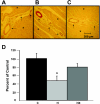Short-term exercise training prevents micro- and macrovascular disease following coronary stenting
- PMID: 20299615
- PMCID: PMC2886674
- DOI: 10.1152/japplphysiol.01014.2009
Short-term exercise training prevents micro- and macrovascular disease following coronary stenting
Abstract
The purpose of this study was to determine the effects of exercise on coronary blood flow and macrovascular atherosclerosis in response to stent deployment. Male Yucatan swine were placed on a control diet (C); on a high-fat/cholesterol diet (hypercholesterolemic; H); or on a high-fat/cholesterol diet and aerobically exercise trained (HX) starting after 36 wk on the diet. All pigs underwent coronary angiography and intravascular ultrasound (IVUS) guided placement of a bare metal stent in the circumflex coronary artery after 40 wk on diets and 3 wk later pigs underwent repeat angiography and IVUS and coronary blood flow (CBF) measurement. Average peak velocity (APV) was measured under basal conditions and in response to intracoronary application of the endothelium-independent vasodilator adenosine and the endothelium-dependent vasodilator bradykinin. There was a similar approximately 8-fold increase in total cholesterol in H and HX compared with control. Baseline CBF was increased above control and H in HX (P<0.05). At all doses adenosine-induced CBF was impaired in H, but preserved in HX. Similarly, bradykinin-induced CBF was impaired in H vs. control, yet was potentiated in HX. Microvessel density was decreased in H and preserved in HX vs. control. Native atheroma in HX was lower relative to H and control, while in-stent stenosis in HX was not different from H. Hyperlipidemia-induced microvascular dysfunction after stent deployment may be a result of reduction in microvessel density. This is the first report that short-term exercise training near the time of stenting prevents stent-induced microvascular dysfunction and attenuates native atheroma independent of changes in plasma cholesterol in this porcine model.
Figures




References
-
- Beaver BV, Reed W, Leary S, McKiernan B, Bain F, Schultz R, Bennett BT, Pascoe P, Shull E, Cork LC, Francis-Floyd R, Amass KD, Johnson R, Schmidt RH, Underwood W, Thornton GW, Kohn B. 2000 Report of the AVMA panel on euthanasia. JAMA 218: 669–696, 2001 - PubMed
-
- Belardinelli R, Georgiou D, Ginzton L, Cianci G, Purcaro A. Effects of moderate exercise training on thallium uptake and contractile response to low-dose dobutamine of dysfunctional myocardium in patients with ischemic cardiomyopathy. Circulation 97: 553–561, 1998 - PubMed
-
- Belardinelli R, Paolini I, Cianci G, Piva R, Georgiou D, Purcaro A. Exercise training intervention after coronary angioplasty: the ETICA trial. J Am Coll Cardiol 37: 1891–1900, 2001 - PubMed
-
- Best PJM, McKenna CJ, Hasdai D, Holmes DR, Jr, Lerman A. Chronic endothelin receptor antagonism preserves coronary endothelial function in experimental hypercholesterolemia. Circulation 99: 1747–1752, 1999 - PubMed
-
- Camici PG, Crea F. Coronary microvascular dysfunction. N Engl J Med 356: 830–840, 2007. - PubMed
Publication types
MeSH terms
Grants and funding
LinkOut - more resources
Full Text Sources
Medical

